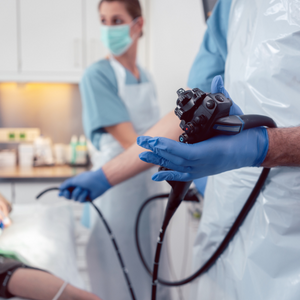EGD

An EGD, or esophagogastroduodenoscopy, is a procedure that allows a doctor to examine the lining of the esophagus, stomach, and duodenum (the first part of the small intestine). An EGD is performed using an endoscope, which is a flexible tube with a light and camera on the end.
During the procedure, the endoscope is passed through the mouth and into the upper digestive tract. The doctor can then view the lining of the esophagus, stomach, and duodenum on a monitor and look for any abnormalities, such as ulcers, inflammation, or cancer. The doctor may also take biopsies (small tissue samples) to be examined under a microscope. An EGD is typically performed as an outpatient procedure, meaning that the patient does not need to stay overnight in the hospital.
Diagnosis
EGD is used to diagnose and treat a variety of digestive disorders, including acid reflux, swallowing problems, ulcers, causes of blood loss and celiac disease. It can also be used to check for signs of cancer or other abnormalities in the digestive tract. An EGD is a -minimally invasive procedure, meaning that it does not require a surgical incision. Most people are able to return to their normal activities the following day of the procedure, with minimal downtime.
Benefits & Risks
It is important to discuss the risks and benefits of EGD with your doctor before the procedure. Your doctor can help you make an informed decision about whether EGD is the right choice for you.
Benefits:
- Allows the doctor to directly visualize the lining of the esophagus, stomach, and duodenum, which can help to diagnose and treat a variety of digestive disorders.
- The procedure can be used to identify and biopsy (take a small tissue sample of) any abnormal areas in the digestive tract, such as ulcers, inflammation, or cancer.
- Can help to determine the cause of symptoms such as difficulty swallowing, abdominal pain, or bleeding from the digestive tract.
Risks:
- Bleeding.
- Infection.
- Perforation (tear) of the esophagus, stomach, or duodenum.
- There is a small risk of aspirating (breathing in) food, vomit, or stomach contents during the procedure.
- Complications from the sedative used during the procedure, such as an allergic reaction or difficulty breathing.
FAQs
EGD, or esophagogastroduodenoscopy, is a procedure that allows a doctor to examine the lining of the esophagus, stomach, and duodenum (the first part of the small intestine). It is typically performed using an endoscope, which is a flexible tube with a light and camera on the end.
During the procedure, the endoscope is passed through the mouth and into the digestive tract. The doctor can then view the lining of the esophagus, stomach, and duodenum on a monitor and look for any abnormalities. The doctor may also take biopsies (small tissue samples) to be examined under a microscope. EGD is usually done under conscious sedation, which means the patient is awake but relaxed and may not remember much of the procedure.
There are risks associated with EGD, including bleeding or infection at the site where the endoscope was inserted, perforation (tear) of the esophagus, stomach, or duodenum, and reactions to the sedative used during the procedure. There is also a small risk of aspirating (breathing in) food, vomit, or stomach contents during the procedure.
The benefits of EGD include the ability to diagnose and treat a variety of digestive disorders, the ability to identify and biopsy any abnormal areas in the digestive tract, and the ability to determine the cause of symptoms such as difficulty swallowing, abdominal pain, or bleeding from the digestive tract. EGD is also a non-invasive procedure with a quick recovery time.
The length of the EGD procedure will vary depending on the individual and the specific reasons for the procedure. In general, the procedure takes about 15-30 minutes to complete.
Most people do not find an EGD to be a painful procedure. The endoscope is inserted through the mouth and into the digestive tract, and most people only feel a slight pressure or discomfort. The procedure is usually done under conscious sedation, which helps to relax the patient and reduce any discomfort.
After the EGD procedure, you may feel a little groggy or have a sore throat for a day or two. You should be able to eat and drink normally after the procedure, although you may be advised to avoid certain foods or activities until any discomfort subsides. It is important to follow the instructions of your medical team and report any concerns or problems to them.
An EGD can be used to detect abnormalities in the lining of the esophagus, stomach, and duodenum, including cancer. If the doctor sees any abnormal areas during the procedure, they may take a biopsy (small tissue sample) to be examined under a microscope. This can help to confirm or rule out cancer or other conditions.